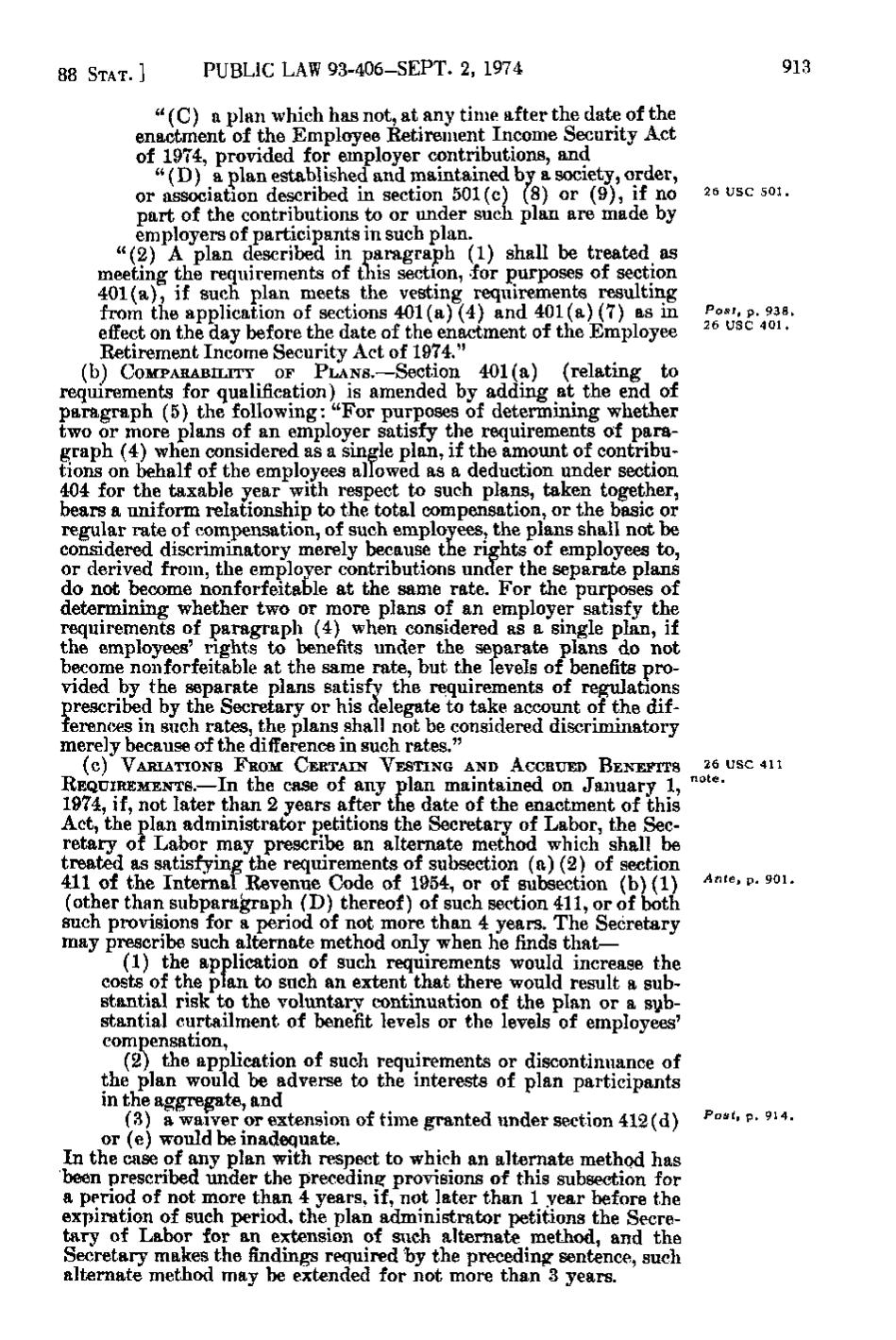88 STAT. ]
PUBLIC LAW 93-406-SEPT. 2, 1974
" (C) a plan which has not, at any time after the date of the enactment of the Employee Retirement Income Security Act of 1974, provided for employer contributions, and " (D) a plan established and maintained by a society, order, or association described in section 501(c)(8) or (9), if no part of the contributions to or under such plan are made by employers of participants in such plan. "(2) A plan described in paragraph (1) shall be treated as meeting the requirements of this section, for purposes of section 401(a), if such plan meets the vesting requirements resulting from the application of sections 401(a)(4) and 401(a)(7) as in effect on the day before the date of the enactment of the Employee Retirement Income Security Act of 1974." (b) COMPARABILITY OF PLANS.—Section 401(a) (relating to requirements for qualification) is amended by adding at the end of paragraph (5) the following: "For purposes of determining whether two or more plans of an employer satisfy the requirements of paragraph (4) when considered as a single plan, if the amount of contributions on behalf of the employees allowed as a deduction under section 404 for the taxable year with respect to such plans, taken together, bears a uniform relationship to the total compensation, or the basic or regular rate of compensation, of such employees, the plans shall not be considered discriminatory merely because the rights of employees to, or derived from, the employer contributions under the separate plans do not become nonforfeitable at the same rate. For the purposes of determining whether two or more plans of an employer satisfy the requirements of paragraph (4) when considered as a single plan, if the employees' rights to benefits under the separate plans do not become nonforfeitable at the same rate, but the levels of benefits provided by the separate plans satisfy the requirements of regulations prescribed by the Secretary or his delegate to take account of the differences in such rates, the plans shall not be considered discriminatory merely because of the difference in such rates." (c)
VARIATIONS FROM CERTAIN VESTING AND ACCRUED BENEFITS
913
26 USC soi.
Post, p. 938. 26 USC 401.
26 USC 411
REQUIREMENTS.—In the case of any plan maintained on January 1, "°*^' 1974, if, not later than 2 years after the date of the enactment of this Act, the plan administrator petitions the Secretary of Labor, the Secretary of Labor may prescribe an alternate method which shall be treated as satisfying the requirements of subsection (a)(2) of section 411 of the Internal Revenue Code of 1954, or of subsection (b)(1) ^"'^' P- ^°^(other than subparagraph (D) thereof) of such section 411, or of both such provisions for a period of not more than 4 years. The Secretary may prescribe such alternate method only when he finds that— (1) the application of such requirements would increase the costs of the plan to such an extent that there would result a substantial risk to the voluntary continuation of the plan or a sybstantial curtailment of benefit levels or the levels of employees' compensation, (2) the application of such requirements or discontinuance of the plan would be adverse to the interests of plan participants in the aggregate, and (3) a waiver or extension of time granted under section 412(d) ^°^ ^' ^^'*" or (e) would be inadequate. I n the case of any plan with respect to which an alternate method has been prescribed under the preceding: provisions of this subsection for a period of not more than 4 years, if, not later than 1 year before the expiration of such period, the plan administrator petitions the Secretary of Labor for an extension of such alternate method, and the Secretary makes the findings required by the preceding sentence, such alternate method may be extended for not more than 3 years.
�
